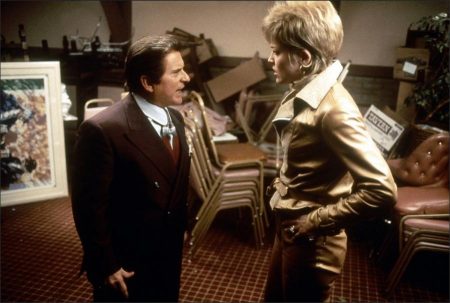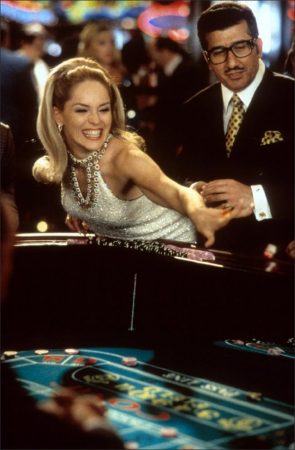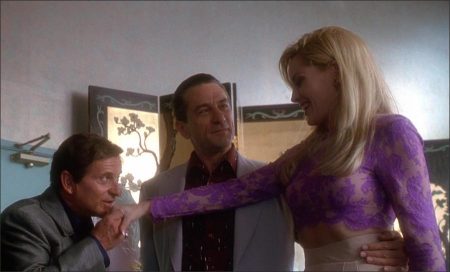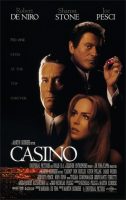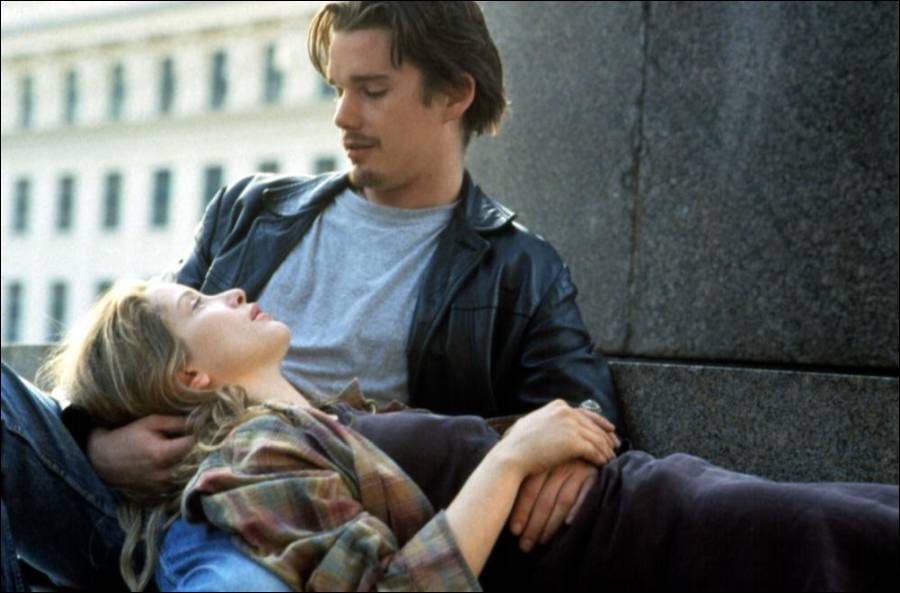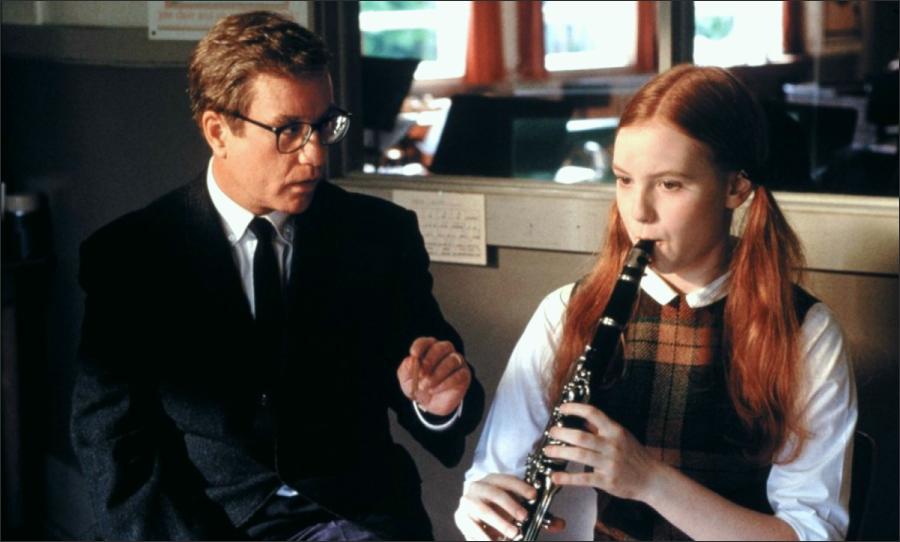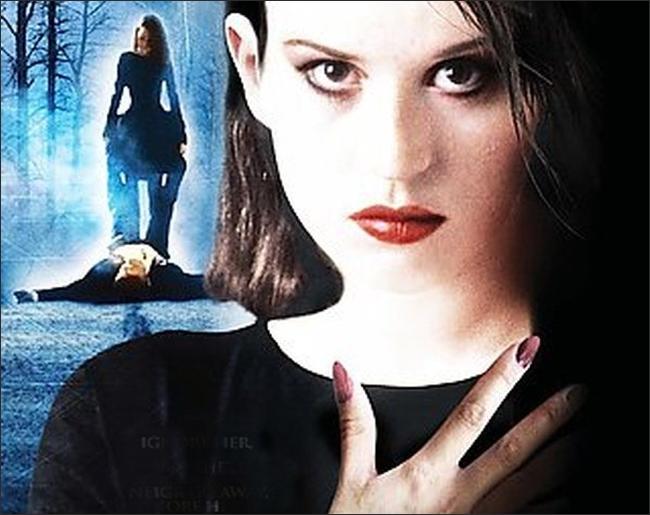Casino Movie Trailer. Of all the bravura visual effects in Martin Scorsese’s dazzlingly stylish “Casino,” it’s a glimpse of ordinary people that delivers the greatest jolt. Strategically timed to offset three hours’ worth of vintage Las Vegas glitter, it’s a reminder that Mr. Scorsese has given this film’s setting the surreal and breathtaking intensity of a money-mad mirage. The real world looks shockingly impoverished by comparison.
With its rivers of cash and mountains of neon, its high rollers and lowlife hoods, “Casino” luxuriantly explores the anatomy of America’s gaudiest (and now most cinematically popular) playground. The place is quagmire enough for an epic morality play, but this film’s tone is staunchly journalistic, as borne out by its matter-of-fact last words: “And that’s that.”
So “Casino,” based on reportorial work by Nicholas Pileggi, comes equipped with the liabilities of investigative journalism: no conveniently sharp focus, a plot built like a centipede and characters with lives too messy to form conventional dramatic arcs. But the material unearthed by Mr. Pileggi also features truths much stranger than fiction, wildly histrionic showdowns, intricate mob trivia and people whose Faustian conniving and obsessive fury fit perfectly into the Scorsese canon. Mr. Scorsese has been here and done this already in “Goodfellas,” but not with his new film’s blistering bitterness or its peacock extravagance. The long, astonishing Copacabana sequence in “Goodfellas” was only a warm-up for this.
Mr. Pileggi, Robert De Niro and Joe Pesci, all “Goodfellas” alumni, are back in familiar capacities, joining Mr. Scorsese to do what they do best. But “Casino” also has a new ingredient in Sharon Stone, who will be nobody’s idea of Hollywood fluff after this spectacular, emblematic performance. As Ginger McKenna, a gorgeous hustler who falls from the ranks of Vegas’s royalty to its lowest depths, she represents the full range of this film’s stark extremes. Like all the film’s principal characters, Ginger is a renamed and slightly modified version of the woman described in Mr. Pileggi’s book. But her most crazily extreme behavior is true to his account.
“Casino” is chiefly about a gambling prodigy — called Sam (Ace) Rothstein in the film — who supervised a thriving hotel casino in its glory days. More number-cruncher than swaggering mobster, Ace was fastidious enough to regulate the number of blueberries in his restaurant’s blueberry muffins. When it came to the showgirls in his nightclub, he kept track of their exact weight without, it seems, even bothering to ogle.
So Ace depended on the mad-dog energies of his vicious best friend, Nicky Santoro — at least until Nicky became a menace. “We made a great pair,” Ace recalls in the voice-over, which is one of the film’s bolder moves, since one of the two narrators turns out to be speaking from beyond the grave. “I made book, and Nicky made sure we always collected.”
From those simple beginnings, with Mr. De Niro and Mr. Pesci cast ideally as Ace and Nicky, “Casino” spins a gigantic web. It outlines the intricacies of casino cheating; the complex financial structure linking casino profits to mob bosses in Kansas City; the greased-palm etiquette ruling all Las Vegas, from its politicians to its valet parkers; the Federal investigation that had Ace and Nicky dodging surveillance planes, wiretaps and lip-readers, and even the blinding peculiarities of local fashion and interior decor.
Outlandish and yet becoming, the flashy 1970’s costumes are a movie in themselves thanks to Rita Ryack and John Dunn, who show off Ms. Stone to traffic-stopping effect and find Ace more colors than there are in the rainbow. Costume and character are well linked, as when Ace sits in his office in a shirt, white socks and turquoise loafers, keeping his turquoise pants on a hanger unless company appears. Meanwhile, Dante Ferretti, a long way from “The Age of Innocence,” contributes wonderfully witty and affectionate production design.
Sometimes the film overloads its audience’s capacity to absorb arcane schemes or fiscal data; sometimes it takes off on abrupt tangents. Occasionally it seems repetitive, but most of it is agile and enveloping, economically packing in a wealth of detail.
In a town where even marriage is a business deal, Ace makes a gambler’s proposal to Ginger: “Wanna take a chance?” She responds in kind, demanding jewelry from Ace without abandoning an old boyfriend whom the film slyly calls Lester Diamond. Played with suitable sleaze by James Woods, Lester is described by Ace as “a moocher, a card cheat, a country club golf hustler chasing dentists for a few bucks.” Even this film’s many minor figures are sharply drawn.
Lester, Nicky, booze, greed and hubris all contribute to the breakdown of Ace and Ginger’s marriage, culminating in a riotous, terrible meltdown that makes for one of the most scorching episodes Mr. Scorsese has ever filmed. “Casino” depicts some savage gangland violence (most of it brief), but its chief viciousness is reserved for the domestic arena. Look elsewhere for moral lessons or warm, fuzzy accounts of true love.
“Casino” doesn’t do as much as it might have with the tale of Ace and Ginger’s merger, which shares the whole film’s taste for gleaming surface over inner depth. But it does know why Ace’s first sight of Ginger, on a black and white surveillance camera scanning the casino, is enough to stop him cold. At pivotal moments, the film’s terrific pop score (supervised by Robbie Robertson, ranging from “Stardust” and soul to the Rolling Stones and Devo) delivers just the right ironic commentary on the action. At Ginger and Ace’s wedding, “What a Difference a Day Makes” says it all.
“Casino” is rated R (Under 17 requires accompanying parent or adult guardian). It includes frequent profanity and several quick but graphic violent episodes involving beatings, a stabbing and a head caught in a vise.
Casino (1995)
Directed by: Martin Scorsese
Starring: Robert De Niro, Sharon Stone, Joe Pesci, Don Rickles, Kevin Pollak, James Woods, Alan King, L.Q. Jones, Frank Vincent, Melissa Prophet, Vinny Vella
Screenplay by: Nicholas Pileggi, Martin Scorsese
Production Design by: Dante Ferretti
Cinematography by: Robert Richardson
Film Editing by: Thelma Schoonmaker
Costume Design by: John Dunn
Set Decoration by: Rick Simpson
Art Direction by: Jack G. Taylor Jr.
MPAA Rating: for strong brutal violence, pervasive strong language, drug use and some sexuality.
Distributed by: Universal Pictures
Release Date: November 22, 1995
Views: 236
